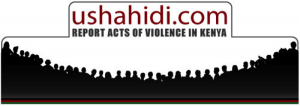By MollyJust

“We believe that the number of deaths being reported by the government, police, and media is grossly under reported. We also don’t think we have a true picture of what is really going on – reports that all have us have heard from family and friends in affected areas suggests that things are much worse than what we have heard in the media.
We also (in my idealist world) hope that we can begin to put names and faces to the people who have lost their lives in this mess.
What’s the point of all this you might ask? Well, Kenyans have demonstrated their capacity for selective amnesia time and time again. When this crisis comes to an end we don’t want what happened to be swept under the rug in the name of “moving forward” – for us to truly move forward, the truth of what happened needs to be told – Ushahidi (www.ushahidi.com) is our small way of contributing to that”.
Ushahidi is a small Kenyan-born organization that develops free, open source software for information gathering, visualization, and interactive mapping. Originally designed to map reports of post-election violence in Kenya, Ushahidi has since then developed into a social collaboration tool turning citizens into journalists all over the world. The organization combines crowdsourcing, social activism, citizen journalism, and geospatial information into a resultant product that has been called one of the most disruptive innovations of the last decade. The Ushahidi Platform allows local observers to send reports using their mobile phones or the Internet, while concurrently constructing a time-based, geospatial archive of incidents.
In 2008, after Kenya’s contentious election, violence exploded across the country. After receiving threats about her work, a well-known Kenyan lawyer and blogger Ory Okolloh wrote about the idea of an Internet mapping tool that would allow people to report violence anonymously. Software engineers that read Ms. Okolloh’s blog built the Ushahidi Web Platform over a long weekend and the site was up and running soon afterwards. The Kenyan website allowed users to submit eyewitness reports of riots, stranded refugees, rapes, and murders via email and text-message and placed the events on a Google map.
When the Haitian earthquake struck, Ushahidi quickly built a Web Platform for the Haitian people. An emergency number for texting was advertised on the radio and Ushahidi received thousands of messages reporting trapped victims. The messages were translated by a widespread band of Haitian-Americans in the U.S and quickly plotted on a “crisis map”. From a room at the Fletcher School of Law and Diplomacy at Tufts University, Ushahidi volunteers worked with the United States Coast Guard in Haiti helping locate survivors. After the Chilean earthquake, Ushahidi quickly organized again.
There are many potential problems with the Ushahidi Web Platforms. People could lie, addresses could be wrong, or the reports of violence could be exaggerated. But as data collects, Ushahidi maps can expose underlying pattern. How large was the radius of the earthquake’s devastation? How many miles inland did the hurricane cause catastrophic damage? Are the murders broadly distributed or focused near military bases?
With tools like Ushahidi, humanitarian work can now operate much differently than it has in the past. In the past, humanitarian work was limited in part by the small number of foreign journalists who were able to get to a disaster location and report on events there. Now victims on the ground can supply real-time information to a horde of global volunteers ready to translate the text messages and help orchestrate relief.
Ushahidi represents a new type of innovation. Entrepreneurship derived from hardship and suffering. These innovators concentrate on doing more with less and the consequences have been nothing less of amazing. Because Ushahidi was an idea born out of a crisis, no one tried to capitalize on its launch. The organization used open-source software and was therefore able to let others alter the tool for new projects. “Ushahidi remixes” have been used in Armenia and India to monitor elections; in the Middle East to report on the Gaza War; in Africa to report on medicine shortages; and in Washington DC to map road blockages and the location of available snowplows.
Innovations like Ushahidi and the organizations other data processing tools like Swift River are truly changing the landscape of disaster relief and humanitarian work.
Related articles
- Ushahidi and Designing for Data: Next Steps (disaster-net.com)
- Ushahidi – Crowdsourcing Democracy, from Kenya to the World (ieet.org)
- Selflessness, Sympathy and Social Media..Ushahidi (irenekamau.wordpress.com)
- An update: Crowdsourcing, Crisis Mapping and Elections (ushahidi.com)
- Case Study: Ushahidi in Kenya (portlandforward.com)


Leave a Reply
You must be logged in to post a comment.